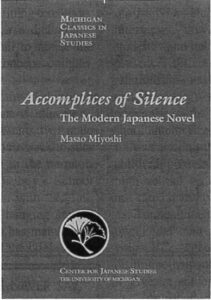by Masao Miyoshi
MICHIGAN CLASSICS IN JAPANESE STUDIES, NO. 15
ANN ARBOR: THE UNIVERSITY OF MICHIGAN, 1996
Miyoshi closely analyzes six representative novelists within a general context that considers Japanese cultural interaction with the novel defined as an imported Western form. The writers are Futabatei Shimei, Mori Ogai, and Natsume Soseki of the Meiji and early Taisho eras; and Kawabata Yasunari, Dazai Osamu, and Mishima Yukio of the Hirohito (Showa) years. Miyoshi reveals structural characteristics of the Japanese novel, as well as more abstract thematic consequences of cultural importation. He also examines the often traumatic role played by the authors’ own lives in the process.
 We are introduced to Futabatei, whose Ukigumo (The Drifting Clouds), published in parts and serialized between 1887 and 1889, is considered to be the first modern Japanese novel, in the context of the contemporary gembun’itchi movement. Its proponents advocated bringing written and spoken modes of discourse closer together in Japan, in extreme cases proposing the adoption of the Roman alphabet and even the abolition of Japanese altogether in favor of English. Sociocultural factors embedded in Japanese culminate in an ultimate “passion for silence” (xv) that Miyoshi argues accounts for a “death wish operating throughout modem Japanese literature” (178). Mishima’s public harakiri is, of course, the most notorious instance of this impulse to self-sacrifice, but he shares the trait with Kawabata and Dazai, along with an abundance of others: the editor of a special literary number inspired by the Mishima incident reckoned the suicide rate for Japanese writers to be three hundred times higher than that of the rest of the population.
We are introduced to Futabatei, whose Ukigumo (The Drifting Clouds), published in parts and serialized between 1887 and 1889, is considered to be the first modern Japanese novel, in the context of the contemporary gembun’itchi movement. Its proponents advocated bringing written and spoken modes of discourse closer together in Japan, in extreme cases proposing the adoption of the Roman alphabet and even the abolition of Japanese altogether in favor of English. Sociocultural factors embedded in Japanese culminate in an ultimate “passion for silence” (xv) that Miyoshi argues accounts for a “death wish operating throughout modem Japanese literature” (178). Mishima’s public harakiri is, of course, the most notorious instance of this impulse to self-sacrifice, but he shares the trait with Kawabata and Dazai, along with an abundance of others: the editor of a special literary number inspired by the Mishima incident reckoned the suicide rate for Japanese writers to be three hundred times higher than that of the rest of the population.
Miyoshi’s aesthetics in his concentrated readings and his aim to demonstrate both the successes and failures of the Japanese novel refer consistently to closely related points of cultural and linguistic differential. Variability in Japanese tense contributes to temporal disorientation and a sense of existential “drifting” in Futabatei’s The Drifting Clouds and to Soseki’s masterly temporal play in the “haiku novel” Pillow of Grass (Kusamakura, 1906). The syntactical flexibility of the original Japanese version of Snow Country (Yukiguni, 1937) magnifies Kawabata’s blending of human incidents into the passage of time. The implication is that Kawabata’s innovative approach to the novel, with its opposition to a plot logic of cause, effect, and moral consequence, sterns from Japanese elements extraneous to the Western form. Similarly, Soseki’s Pillow of Grass employs a unique visual effect that contributes to the painterly quality of its narrative (the narrator is, in fact, an artist). Some passages need to “be seen, not heard, to be understood” (64), due to very obscure Chinese characters that few of its Japanese speaking readers would be able to pronounce.
Miyoshi finds a persistent source of difficulty for the Japanese novel-and, indeed, for Japanese novelists-in what he describes as a rigidly hierarchical, strictly role-defined society and a consequent “poverty of real content in Japanese life” (178). Japanese society, he argues, represses the development of individual personality that is by definition a prerequisite for the novelistic imagination as well as nurture for characters and authors alike. Paradoxically, the Japanese autobiographical genre of the “I-novel” or shi-shosetsu evolves out of this very factor, substituting the author’s private world for what is traditionally a network of relationships among individuals. For Miyoshi, however, the I-novel generally suffers as a type of novel for its dearth of clear personalities. He observes in it a paradigm for the literary suicide phenomenon: once the writer’s life is mined of its content, suicide offers the only alternative to nauseating redundancy.
It would not seem fair to judge Miyoshi for his recourse in 1974, when the book was originally published, to what these days attracts criticism as an ideologically conditioned view of Japanese society as uniquely homogeneous and anti-individualistic. In his subsequent Off Center: Power and Culture Relations Between Japan and the United States (Cambridge: Harvard, 1991) and with Postmodemism and Japan (Durham: Duke University Press, 1989), coedited with H. D. Harootunian, Miyoshi proves himself a leading figure in the quest to forge a culturally conscious critical framework, one “decentered” from a Western perspective. For educators about Asia, a minor point of caution might be advised here not simply to transmit the stereotypes that surface in places, signposted but not explicated as “myth.” Jn the broader context, Miyoshi’s book remains a tour de force in an ongoing intellectual program to understand Japanese culture and its complex relation to the West, fully warranting its present inclusion in a series of “classics” in Japanese studies.

